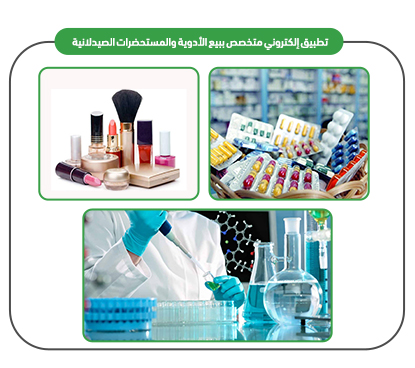Mashroo3k Consulting Company offers a comprehensive feasibility study for the e-pharmacy project, which is an electronic application for selling medications, cosmetics, and medical supplies online.

The electronic pharmacy achieves the ability to reach the largest number of customers in different places. It also provides marketing features that help increase demand for products offered for sale, such as: medicines, cosmetics, medical supplies, and laboratory supplies.
The concept of an e-pharmacy project relies on selling medications online and delivering them to patients at a convenient time. An e-pharmacy differs from a traditional pharmacy in that it can communicate with a larger number of customers from different locations at the same time.
The electronic pharmacy allows easy communication between the pharmacist and the patient, which makes him able to provide a detailed diagnosis service, describe treatment mechanisms, alternatives to available medications, explain the correct drug doses, contraindications to use, and side effects.
The electronic pharmacy is characterized by its variety of options, between requesting a specific medication according to the doctor’s instructions, or requesting medical advice. Payment can be made in cash or by various credit cards. It also allows the patient to choose the appropriate timing and location for delivery.
The e-pharmacy project keeps pace with the tremendous surge witnessed in the healthcare sector following the outbreak of the COVID-19 pandemic, in addition to the recent developments in the field of e-commerce.



Compatible with all Android and iOS devices.
Control panel available in both Arabic and English.
User interfaces are designed to be intuitive and user-friendly.
Easy to add or block new clients using their phone number.
Option to receive service fees either in cash or through electronic payment (MasterCard or Visa).
Ability to receive complaints and respond to customer messages.
Announce new services instantly by sending bulk notifications to customers.
Access to customer ratings for each service and the employee who performed it.
Ability to chat with customers via text.
Protection against sabotage or hacking, as it is equipped with the strongest security and protection systems.
24/7 technical support service available.
Executive summary
Study project services/products
Market Size Analysis
Risk Assessment
Technical study
Financial study
Organizational and administrative study

A Look at E-Commerce Statistics in the GCC Countries:
In 2015, e-commerce contributed approximately 0.4% of the total GDP of the Gulf Cooperation Council (GCC) countries, amounting to $5.3 billion.
By 2020, with the economic shifts brought about by the COVID-19 pandemic, the e-commerce market in the GCC had become one of the fastest-growing markets globally, with a growth rate exceeding 35%. The market size was estimated at around $24 billion, surpassing earlier projections of $21.6 billion.
Here is a detailed look at the size of the e-commerce market in the GCC over the past five years:
Global reports predict that e-commerce in the GCC will grow at an accelerated rate between 2020 and 2022 by 20%, and by 14% through 2025. Without the impact of COVID-19, the expected growth would have been 14% and 10%, respectively.
The average percentage of households purchasing goods online rose from 2% to over 8%. In comparison, this rate ranges between 16% and 25% in developed countries like the United States, South Korea, and Germany. However, projections suggest that GCC countries will soon reach similar global levels.
Visits to popular shopping websites increased by 50% in 2020 compared to 2015, with the number of users rising from 3 million to 21 million.
The number of e-commerce platforms and applications has tripled compared to 2015.
The time users spend on websites such as Amazon, Namshi, and Noon has increased, with average daily browsing times ranging from 9 to 12 minutes and users viewing between 7 to 8 pages.
Food and grocery delivery services are among the fastest-growing sectors in e-commerce, with a growth rate of 20% and a current market size of $3 billion in the GCC.
Fashion and beauty activities represent a significant investment opportunity in this sector, with an 18% growth rate and a current market size exceeding $5 billion in the region.
A Detailed Outlook on E-Commerce Growth Forecasts in the GCC for the Next Five Years:
60% of millennials shop online.
By 2025, the GCC e-commerce market is expected to reach $50 billion.
Millennials make up more than 45% of the population in GCC countries, making the region a highly promising market for e-commerce.
